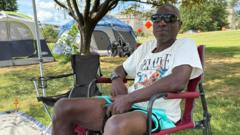In a controversial move, President Trump posted a photo of a homeless man, Bill Theodie, sitting by his tent in Washington, D.C. The post ignited a crackdown on tent encampments in the capital, with Trump demanding their immediate removal, describing them as "slums." The announcement triggered rapid action from local officials, who warned residents that they had to leave or face bulldozers clearing the area.
The encampment, once the largest in the city, saw its inhabitants like Theodie and others scrambling to gather their belongings as local officials reinforced the order for their eviction. While some residents managed to find temporary accommodations in motels, many expressed concerns about the limited space available in shelters and fear for their safety.
Struggling against eviction, Theodie had been living there for years and described the situation as surreal, especially after finding out he'd been photographed for political commentary. The push to disband encampments reflects a broader issue of homelessness in the U.S., which has recently witnessed drastic enforcement measures but continues to have a high number of individuals living on the streets. As neighborhoods grapple with the implications of these actions, the dialogue around effective solutions remains urgent.
The encampment, once the largest in the city, saw its inhabitants like Theodie and others scrambling to gather their belongings as local officials reinforced the order for their eviction. While some residents managed to find temporary accommodations in motels, many expressed concerns about the limited space available in shelters and fear for their safety.
Struggling against eviction, Theodie had been living there for years and described the situation as surreal, especially after finding out he'd been photographed for political commentary. The push to disband encampments reflects a broader issue of homelessness in the U.S., which has recently witnessed drastic enforcement measures but continues to have a high number of individuals living on the streets. As neighborhoods grapple with the implications of these actions, the dialogue around effective solutions remains urgent.



















